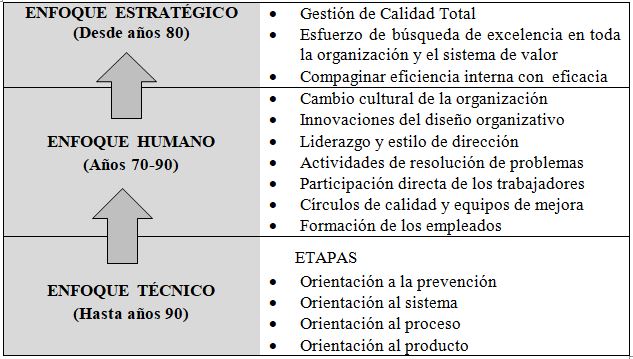ISO 9000: Evolution towards total quality
DOI:
https://doi.org/10.13140/RG.2.2.27619.48162Keywords:
quality management, ISO 9000, total quality, standardsAbstract
This article is intended to analyze the evolution of the quality management concept through the ISO 9000 series of standards. To this end, the versions of these standards are examined and compared with the quality management definitions proposed by different authors. The results of this research make it possible to conclude that the ISO 9000 series of standards has been changing its position with regard to quality management, moving from a product-centric model to one focused on market demands. There is a greater influence, in the most recent versions of the standard, of the principles and practices of Total Quality materialized especially in the eight principles and in the model of the process-based Quality Management System, defined in the version of the year 2000 and maintained and deepened in the versions of 2008 and 2015.
Downloads
References
M. Umeda. ISO e TQC-o camino em busca de GQT. Fundacao Christiano Ottoni. Belo Horizonte. 1996.
S. Anderi. ISO 9000. Implantación de Sistemas de Calidad. Vadell Hermanos. Editores. Caracas. 1994.
L. Lemur. Algunas consideraciones sobre las interrelaciones de las buenas prácticas de producción con las normas de la serie ISO 9000. Biotecnologia Aplicada. 13(2): 148-153. 1996. httpp://www.bioline.org.br/request?ba96072.
FONDONORMA. Compendio Normas Venezolanas COVENIN-ISO 9000:2000. 2002. Caracas.
FONDONORMA. COVENIN-ISO 9001:2008. Sistemas de Gestión de la Calidad. Requisitos. 2008. Caracas.
F.L. Cruz-Medina, A. López-Diaz, C. Cárdenas. Sistemas de Gestión ISO 9001-2015: Técnicas y Herramientas de Ingeniería de calidad para su implementación. Revista Ingeniería, Investigación y Desarrollo, 17(1): 59-69. 2017.
ISO. Norma Internacional ISO 9001:2015. Sistemas de Gestión de la Calidad. Requisitos. Traducción Oficial. 2015.
J.W. Dean, D.E. Bowen. Management theory and total quality: improving research and practice through development. Academy of Management Review, 19 (3). 1994.
J. Evans, W. Lindsay, W. Administración y Control de Calidad. Cuarta Edición. Thomson Editores, S.A. México. 2000.
L. Gutiérrez, I. Tamayo. Los modelos de la gestión de la calidad como medios facilitadores para la obtención de flexibilidad estratégica en la organización. Decisiones basadas en el conocimiento y en el papel social de la empresa: XX Congreso Anual de AEDEM, Volumen 1. 2007. http://dialnet.uniroja.es/servlet/articulo/articulo?codigo=2486936.
I. Sila, M. Ebrahimpour. Examination and comparison of the critical factors of total quality management (TQM) across countries. International Journal of Production Research, 41(2), 2003.
C. Camisón, S. Cruz, T. González. Gestión de la Calidad: Conceptos, enfoques, modelos y sistemas. Pearson Educación S.A. Madrid. 2007.
J. Ruiz-Canela. La Gestión por Calidad Total en la Empresa Moderna. ALFAOMEGA Grupo Editor. México. D.F. 2004.
T.J. Fontalvo, E.J De La Hoz. Diseño e Implementación de un Sistema de Gestión de la Calidad ISO 9001:2015 en una Universidad Colombiana. Formación universitaria. 11(1): 35-44. 2018. https://dx.doi.org/10.4067/S0718-50062018000100035
A.M. Buriticá-Macías, C.A. Buriticá-Noreña, G. López-Quintero. ISO 9001 versión 2015 guía de implementación revisión de caso. Scientia et Technica, 24(2):250-254. 2009. http://revistas.utp.edu.co/index.php/revistaciencia/a[rticle/view/22101/13971

Published
How to Cite
Issue
Section
Copyright (c) 2020 Lelis Medici

This work is licensed under a Creative Commons Attribution-NonCommercial-ShareAlike 4.0 International License.
The opinions expressed by the authors do not necessarily reflect the position of the publisher of the publication or of UCLA. The total or partial reproduction of the texts published here is authorized, as long as the complete source and the electronic address of this journal are cited.
The authors fully retain the rights to their works, giving the journal the right to be the first publication where the article is presented. The authors have the right to use their articles for any purpose as long as it is done for non-profit. Authors are recommended to disseminate their articles in the final version, after publication in this journal, in the electronic media of the institutions to which they are affiliated or personal digital media.


